 W
WA babydoll is a short, sleeveless, loose-fitting nightgown or negligee, intended as nightwear for women. It sometimes has formed cups called a bralette for cleavage with an attached, loose-fitting skirt falling in length usually between the belly button and upper thigh. The garment is often trimmed with lace, ruffles, appliques, marabou, bows, and ribbons, optionally with spaghetti straps. Sometimes it is made of sheer or translucent fabric such as nylon or chiffon or silk.
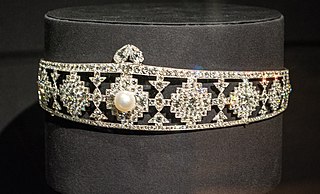 W
WA bandeau is a garment comprising, in appearance, a strip of cloth. Today, the term frequently refers to a garment that wraps around a woman's breasts. It is usually part of a bikini in sports or swimwear. It is similar to a tube top, but narrower. It is usually strapless, sleeveless, and off the shoulder. Bandeaux are commonly made from elastic material to stop them from slipping down, or are tied or pinned at the back or front. In the first half of the 20th century, a "bandeau" was a narrow band worn by women to bind the hair, or as part of a headdress.
 W
WA basque is an item of women's clothing. The term, of French origin, originally referred to types of bodice or jacket with long tails, and in later usage a long corset, characterized by a close, contoured fit and extending past the waistline over the hips. It is so called because the original French fashion for long women's jackets was adopted from Basque traditional dress. In contemporary usage it refers only to a long item of lingerie, in effect a brassiere that continues down, stopping around the waist or the top of the hips, the lower part essentially decorative rather than providing support or indeed warmth.
 W
WA bikini is a women's two-piece swimsuit featuring two triangles of fabric on top that cover the woman's breasts, and two triangles of fabric on the bottom: the front covering the pelvis but exposing the navel, and the back covering the buttocks. The size of the top and bottom can vary, from bikinis that offer full coverage of the breasts, pelvis, and buttocks, to more revealing designs with a thong or G-string bottom that covers only the mons pubis, but exposes the buttocks, and a top that covers little more than the areolae.
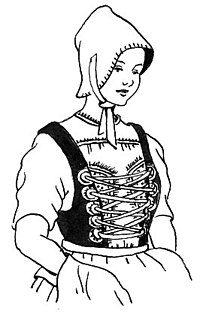 W
WA bodice is an article of clothing for women and girls, covering the torso from the neck to the waist. The term typically refers to a specific type of upper garment common in Europe during the 16th to the 18th century, or to the upper portion of a modern dress to distinguish it from the skirt and sleeves. The name bodice comes from an older garment called a pair of bodies.
 W
WA bra, short for brassiere or brassière, is a form-fitting undergarment designed to support or cover a woman's breasts. Bras are designed for a variety of purposes, including general breast support, enhancing breast size, creating cleavage, or for other aesthetic or practical considerations. Swimsuits, camisoles, and backless dresses may have built-in breast support with supportive bra cups. Nursing bras are designed to facilitate breastfeeding. Some people have a medical and surgical need for brassieres, but most wear them for fashion or cultural reasons. There is no evidence that bras prevent breasts from sagging and one study even suggests the opposite, with the exception of wearing them during sports exercises.
 W
WA bralette is a lightweight bra without an underwire, designed primarily for comfort. Bralettes are also sometimes worn as outerwear, and are also designed as undershirts for children developing breasts.
 W
WThere are a great many brassiere designs that are suitable for a wide variety of business and social settings and suitable to wear with a variety of outer clothing. The bra's shape, coverage, functionality, fit, fashion, fabric, and colour can vary widely. Some bras are designed to offer basic, practical support and coverage while others are purposefully sexual, sensual, or revealing.
 W
WA burkini is a type of modesty swimsuit for women. The suit covers the whole body except the face, the hands and the feet, while being light enough for swimming. The amount of skin covered is about the same as the person wearing a wetsuit and a swimming cap.
 W
WA bustier is a form-fitting garment for women traditionally worn as lingerie. Its primary purpose is to push up the bust by tightening against the upper midriff and forcing the breasts up while gently shaping the waist. Nowadays, it might also be worn as a push-up bra under a low-backed dress or as a camisole for outerwear. The bustier can also be worn as a half-slip under sheer upper garments if a bold display of the midriff is not desired.
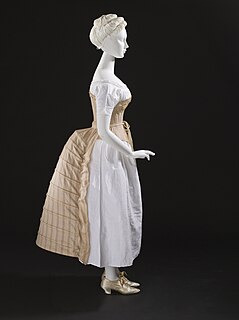 W
WA bustle is a padded undergarment used to add fullness, or support the drapery, at the back of women's dresses in the mid-to-late 19th century. Bustles were worn under the skirt in the back, just below the waist, to keep the skirt from dragging. Heavy fabric tended to pull the back of a skirt down and flatten it. As a result a woman's petticoated skirt would lose its shape during everyday wear.
 W
WA camisole is a sleeveless undergarment / innerwear typically worn by women, normally extending to the waist. The camisole is usually made of satin, nylon, silk, or cotton.
 W
WA chemise or shift is a classic smock, or a modern type of women's undergarment or dress. Historically, a chemise was a simple garment worn next to the skin to protect clothing from sweat and body oils, the precursor to the modern shirts commonly worn in Western nations.
 W
WA crinoline is a stiff or structured petticoat designed to hold out a woman's skirt, popular at various times since the mid-19th century. Originally, crinoline was described as a stiff fabric made of horsehair ("crin") and cotton or linen which was used to make underskirts and as a dress lining.
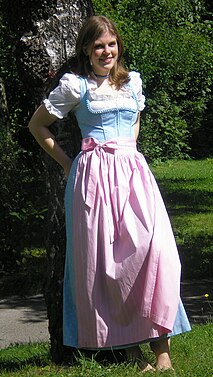 W
WA dirndl (German: [ˈdɪʁndl̩] , is the name of a feminine dress which originated in German-speaking areas of the Alps. It is traditionally worn by women and girls in southern Germany, Austria, Liechtenstein, Switzerland and Alpine regions of Italy. A dirndl consists of a close-fitting bodice featuring a low neckline, a blouse worn under the bodice, a wide high-waisted skirt and an apron.
 W
WA dress is a garment traditionally worn by women or girls consisting of a skirt with an attached bodice. It consists of a top piece that covers the torso and hangs down over the legs. A dress can be any one-piece garment containing a skirt of any length, and can be formal or casual.
 W
WA dudou is a traditional Chinese form of the bodice, originally worn as an undershirt with medicinal properties. With the opening of China, it is sometimes encountered in Western and modern Chinese fashion as a sleeveless shirt and backless halter-top blouse.
 W
WA farthingale is one of several structures used under Western European women's clothing in the 16th and 17th centuries to support the skirts in the desired shape and enlarge the lower half of the body. It originated in Spain in the fifteenth century. Farthingales served important social and cultural functions for women in Renaissance Europe as they were used, primarily by court women, to show their high social position and wealth. This is because these structures increased the amount of expensive fabrics used in the gowns that covered them.
 W
WFrench knickers are a type of women's underwear or lingerie. The term is predominantly used in the United Kingdom (UK) and Australia to describe a style of underpant that is similar in look to a pair of shorts. French knickers are worn from the hip, concealing some of the upper thigh and all of the buttocks. The garment features an "open leg" style that allows for a more comfortable fit and the straight-cut leg cuffs can be designed with or without trimming. The fabric is often bias cut.
 W
WFrench maid was a term applied in the Victorian and early 20th century periods to a lady's maid of French nationality. A lady’s maid was a senior servant who reported directly to the lady of the house, and accompanied her mistress on travel. She helped her mistress with her appearance, including make-up, hairdressing, clothing, jewellery, and shoes, and sometimes served as confidante. A maid of French nationality was considered likely to be more expert in current fashions, and was also able to apply her knowledge of the French language when travelling in Europe.
 W
WA gown, from the Saxon word, gunna, is a usually loose outer garment from knee- to full-length worn by men and women in Europe from the Early Middle Ages to the 17th century, and continuing today in certain professions; later, gown was applied to any full-length woman's garment consisting of a bodice and attached skirt. A long, loosely fitted gown called a Banyan was worn by men in the 18th century as an informal coat.
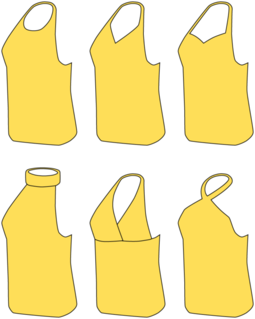 W
WHalterneck is a style of women's clothing strap that runs from the front of the garment around the back of the neck, generally leaving the upper back uncovered. The name comes from livestock halters. The word "halter" derives from the Germanic words meaning "that by which anything is held". Halter is in the German word Büstenhalter, a dated word for bra, with Büste meaning female chest and breasts.
 W
WA hoop skirt or hoopskirt is a women's undergarment worn in various periods to hold the skirt extended into a fashionable shape.
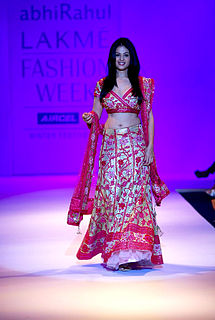 W
WThe lehenga, lehnga or langa is a form of ankle-length skirt that originated in India but is worn by women across the Indian subcontinent, particularly because of the influence of the Indian Hindi film industry popularly known as Bollywood. Different patterns and styles of traditional embroidery are used to decorate the lehenga. Gota patti embroidery is often used for festivals and weddings. The lehenga is sometimes worn as the lower portion of a gagra choli or langa voni.
 W
WThe liberty bodice, like the emancipation bodice or North American emancipation waist, was an undergarment for women and girls invented towards the end of the 19th century, as an alternative to a corset.
 W
WLingerie is a category of primarily women's clothing including undergarments, sleepwear, and lightweight robes. The choice of the word is often motivated by an intention to imply that the garments are alluring, fashionable or both. In a 2015 US survey, 75% of women and 26% of men reported having worn sexy lingerie in their lifetime.
 W
WA miniskirt is a skirt with its hemline well above the knees, generally at mid-thigh level, normally no longer than 10 cm (4 in) below the buttocks; and a dress with such a hemline is called a minidress or a miniskirt dress. A micro-miniskirt or microskirt is a miniskirt with its hemline at the upper thigh, at or just below crotch or underwear level.
 W
WThe negligee or négligée, also known in French as déshabillé, is a form of see-through clothing for women consisting of a sheer usually long dressing gown. It is a form of nightgown intended for wear at night and in the bedroom. It was introduced in France in the 18th century, where it mimicked the heavy head-to-toe style of women's day dresses of the time.
 W
WNurmahali dress is an inexpensive wedding dress with brocade, the introduction of which has been attributed to Nur Jahan (1577–1645). She designed many dresses; the Noormahali marriage dress was one of them. The dress was for poor people, a set for bride and brides groom was priced at only 25 rupees. The dress is still in use.
 W
WA nursing bra is a specialized brassiere that provides additional support to women who are lactating and permits comfortable breastfeeding without the need to remove the bra. This is accomplished by specially designed bra cups that include flaps which can be opened with one hand to expose the nipple. The flap is usually held closed with a simple clasp or hook.
 W
WPanniers or side hoops are women's undergarments worn in the 17th and 18th centuries to extend the width of the skirts at the side while leaving the front and back relatively flat. This provided a panel where woven patterns, elaborate decorations and rich embroidery could be displayed and fully appreciated.
 W
WPanties are a form of underwear primarily worn by women. Panties can be form-fitting or loose. Typical components include an elastic waistband, a crotch panel to cover the genitalia, and a pair of leg openings that, like the waistband, are often made of elastic. Various materials are used, but are usually chosen to be breathable.
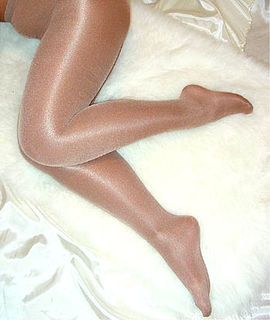 W
WPantyhose, called sheer tights, or sheers in the United Kingdom and a few other countries, are close-fitting legwear covering the wearer's body from the waist to the toes. Mostly considered to be a garment for women and girls, pantyhose first appeared on store shelves in 1959 as a convenient alternative to stockings and/or control panties.
 W
WA petticoat or underskirt is an article of clothing, a type of undergarment worn under a skirt or a dress. Its precise meaning varies over centuries and between countries.
 W
WA poodle skirt is a wide swing felt skirt of a solid color displaying a design appliquéd or transferred to the fabric. The design was often a coiffed poodle. Later substitutes for the poodle patch included flamingoes, flowers, and hot rod cars. Hemlines were to the knee or just below it. It quickly became very popular with teenage girls, who wore them at school dances, and as everyday wear.
 W
WA prairie skirt is an American style of skirt, an article of women's and girls' clothing.
 W
WLe privilège du blanc is a term used for a Catholic custom whereby certain designated royal women are permitted to wear a white dress and veil during audiences with the Pope, an exception to the tradition of women wearing black on such occasions. Those who have been permitted to wear white garments include the Queens of Belgium, Italy and Spain, the Grand Duchess of Luxembourg, and the Princess of Monaco.
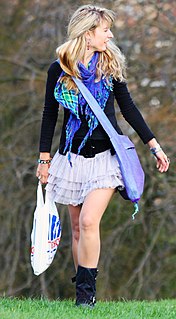 W
WThe rah-rah skirt is a short flounced layered skirt that originated in cheerleading and became a popular fashion trend among teenage girls in the early 1980s. As such it marked, as the Oxford Dictionary noted, the first successful attempt to revive the miniskirt that had been introduced in the mid-1960s. It was created by Angela Stone and Gifi Fields, who based the idea on creating a tutu out of heavier fabric. Later in the 1980s it was often worn with leather, denim or lace.
 W
WA shrug is a cropped, cardigan-like garment with short or long sleeves cut in one with the body, typically knitted, for women. Generally, a shrug covers less of the body than a vest would, but it is more tailored than a shawl. Shrugs are typically worn as the outermost layer of an outfit, with a full shirt, tank top, or dress beneath.
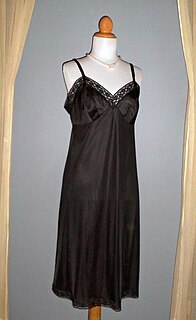 W
WA slip is a woman's undergarment worn beneath a dress or skirt. A full slip hangs from the shoulders, usually by means of narrow straps, and extends from the breast to the fashionable skirt length. A half slip hangs from the waist. The word "petticoat" may also be used for half slips.
 W
WA slip dress is a woman's dress that closely resembles an underslip or petticoat. It is traditionally cut on the bias, with spaghetti straps. The slip dress looked like an undergarment, but was intended to be seen, and through the use of lace and sheer elements, offer glimpses of the body beneath. Designers associated with slip dresses include John Galliano, whose debut design for Dior was a lace-trimmed slip dress worn by Diana, Princess of Wales in 1996; Calvin Klein and Narciso Rodriguez.
 W
WA sports bra is a bra that provides support to a woman's breasts during physical exercise. Sturdier than typical bras, they minimize breast movement and alleviate discomfort. Many women wear sports bras to reduce pain and physical discomfort caused by breast movement during exercise. Some sports bras are designed to be worn as outerwear during exercise such as jogging. There are also sports bras with extra padding for exercises that involve some kind of trauma to the breasts.
 W
WA squaw, fiesta, Kachina, Tohono or patio dress is an American style of dress developed in Arizona. It became popular during the 1940s and 1950s, and many famous women owned these dresses. It was developed primarily by Dolores Gonzales and Cele Peterson, who were inspired by Native American fashion.
 W
WA strapless dress or top is a garment that stays put around the upper body without shoulder straps or other visible means of support. It is usually supported by an internal corset and/or brassiere, with the tightness of the bodice preventing the dress from slipping out of position.
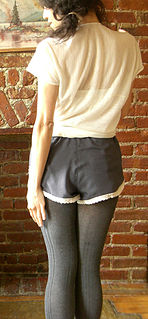 W
WTap pants, also known as side-cut shorts or dance shorts, are a form of lingerie designed for women, similar to French knickers in appearance. As the name implies, they are a type of shorts, in that they cover the pelvic area and the upper part of the upper legs. The name originates from shorts worn by tap dancers during the 1930s while practicing their routines. Tap pants are mostly made of lace, silk, satin, polyester, rayon and cotton voile. Some pairs may be trimmed in ruffles.
 W
WA tube top, colloquially known in the UK as a boob tube, is a shoulderless, sleeveless women's garment that wraps around the upper torso. It is generally tight over the breasts, and usually uses elastic bands at its top and bottom to prevent it from falling. The tube top's precursor was a beachwear or informal summer garment worn by young girls in the 1950s that became more widely popular in the 1970s and returned to popularity in the 1990s and 2000s.
 W
WAn underwire bra is a brassiere that utilizes a thin, semi-circular strip of rigid material fitted inside the brassiere fabric. The wire may be made of metal, plastic, or resin. It is sewn into the bra fabric and under each cup, from the center gore to under the wearer's armpit. The wire helps to lift, separate, shape, and support a woman's breasts. Many different brassiere designs incorporate an underwire, including shelf bras, demi bras, nursing bras, and bras built into other articles of clothing, such as tank tops, dresses and swimsuits.
 W
WA yếm is a traditional Vietnamese bodice used primarily as an undergarment that was once worn by Vietnamese women across all classes. There exists a modern variant called the áo yếm, but the historical garment was simply called a yếm. It was most usually worn underneath a blouse or overcoat, for modesty's sake.